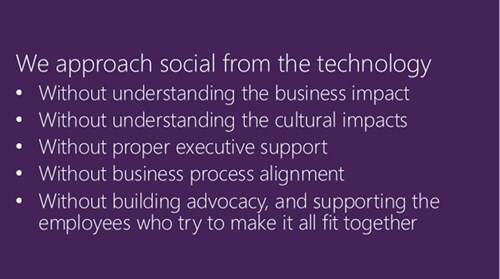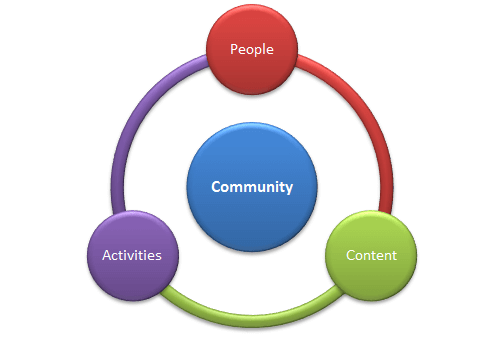The key to higher productivity, cost-efficiency and profitability lies indisputably with your co-workers. Or to be more precise – in their commitment to your business. If you can strengthen their engagement and enthusiasm, productivity is guaranteed to surge. A social intranet has proved to be one of the best means of tapping into your organisation’s potential for greater innovation, knowledge-sharing and employee engagement.
No matter how brilliant and promising your strategies and business plans, they’ll be of little value if your employees are not on board. If it’s difficult to create commitment and consensus, persuading everyone to move in the same direction, there may well be structural, communications or organisational problems. Although an intranet won’t solve the structural issues, it can certainly help bridge them. Most importantly, a social intranet can serve as a platform for inclusive, open and transparent internal communications.
When everyone can communicate freely and easily with anyone in the organisation, and the voices and opinions of all employees are equally important, then new synergies, untamed creativity and enhanced employee engagement will automatically follow.
We are all equals on the net
A properly tuned intranet leads to improved internal communications and collaboration, simplified information management, a higher degree of knowledge-sharing and greater employee engagement. The traditional intranet typically channels information from the top down, which in fact does little more than simulate the old stale analogue communications structure. Information admittedly becomes more accessible, but in no way does it stimulate employee enthusiasm and engagement.
The ability to find and distribute critical information quickly and easily, via role- and task-oriented functions, naturally creates huge efficiencies. But there are probably even greater efficiencies in the social intranet’s capacity to unlock and smoothen organisational structures and borders that have previously hindered internal communications.
The Internet as a whole, and social media in particular, has shown how digitalisation has broken down barriers that used to block communication between different groups and individuals. Today, virtually anyone can exchange a few words with presidents, corporate leaders, the Dalai Lama and even the Pope via social media. Behind our keyboards we are, in fact, digital equals and can discuss freely and openly without the static that personal attributes often creates.
We see the same phenomenon occurring on a vibrant social intranet, where employees are encouraged to participate with their ideas and to help solve problems in chat rooms and on discussion boards. Generally speaking, more people get involved and are more solution- and result- oriented in the digital than in the physical workplace. Those who find it difficult to express themselves in front of a group of people are often released from their phobias and limitations and can more easily vent their views and ideas digitally.
When people see that they are being listened to and that their views and ideas are appreciated, their self-confidence grows, as does their interest in the well-being and future of the organisation. So the whole process evolves into a self-triggering spiral of increased participation and engagement. The more self-confirmation you get, the more active you become.
Adapt the digital workplace to roles and needs
If we are to boost the enthusiasm and sharpen the discipline of employees, then the digital worksplace – just like the physical one – must be customised to their needs and preferences. How this is done varies from one organisation to another. There is, for instance, a huge difference between the communication needs of a healthcare organisation and those of a financial services company. The healthcare employees, for instance, will probably find the task and document management systems and the work shift exchange forums to be the most relevant intranet tools. In the finance company, on the other hand, the stock exchange and legal issues forums are likely to be the most attractive areas.
In order to optimise the usage of the intranet and make sure it encourages employee engagement, it’s vital to work on its attractiveness and make it user-friendly, task-oriented and customised to the specific needs of the organisation. You can, for instance, adapt the information feeds in accordance with the individual employee’s work roles, preferences and access levels. This way, users will find relevant information faster and won’t have to wade through the digital flood to get to it.
Do you want to learn more?
Register for our free webinar How to implement a successful intranet in Office 365 and SharePoint or download the document 45 Important Questions About The Digital Workplace.
Unchain dormant innovative powers
If no-one knows about your talents and knowhow, apart from the ones listed in your job description, they will most likely stay hidden, undiscovered and un-used. It’s a pity for you and a waste of valuable resources for your employer. With well-documented employee competence profiles on the intranet, this kind of resource waste will become a thing of the past. Decision-makers and co-workers can easily find competence, work experience and knowledge resources through the intranet’s smart competence search engines.
Generally speaking, the exchange of knowledge becomes more efficient in an organisation that has adopted an active and well-structured social intranet. Employees are happy to share their knowhow and experiences if they have access to smart tools enabling them to do this. They also regard the intranet as the source of choice for finding reliable knowledge and competence if the search functions are easy to use and the knowledge database is well fed, something that obviously requires a consistent strategy encouraging employees to keep their competence profiles up-to-date at all times. Databases don’t update themselves…
When it’s easy to solve tricky problems or find much-needed competencies, and when your co-workers are eager to share their knowledge on the intranet, the innovative powers of the organisation will automatically flourish and grow.
Feedback and transparency spurs participation
The most interesting discussions are often those held in the coffee room. This is also where new innovative ideas for improvements in the organisation are generated. Sadly though, many good thoughts won’t leave the coffee room and consequently never reach management, the board room or other decision-makers. But when discussions take place on the intranet, inside open subject-oriented and transparent forums, the contents of the debate reach everyone who wants or needs to be informed. It creates participation on a much broader scale and good ideas don’t get locked in.
There’s nothing like good feedback to boost work motivation and employee engagement. At the same time, there are few things more devastating to employee engagement than poor or non-existent feedback. It’s therefore of the utmost importance that you create processes ensuring strict feedback routines in every forum and project in which your employees are encouraged to participate. Your good intentions may otherwise unfortunately backfire.
Reference:
Omnia (2019). A social intranet boosts employee engagement. Available at: https://www.preciofishbone.se/en/omnia/blog/a-social-intranet-boosts-employee-engagement [Accessed: 23rd September 2019].











